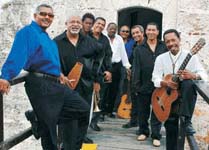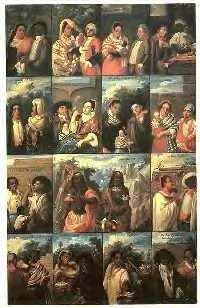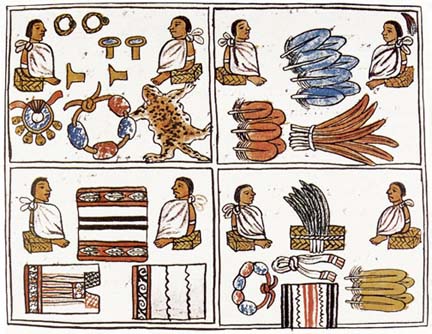|
Libro de Partidas y certificaciones de Matrimonio, número: 4.
Año de 1861. Jerez, Zacatecas
Por Leonardo de la Torre y Berumen
ACOSTA GOMEZ Porfirio, casado y velado el 3 de julio
de 1861 en la iglesia parroquial de Jerez con Ma. Anacleta Saldivar
Enriquez. Foja: 12.
AGUIRRE DE LA ROSA Atilano, casado y velado el 8 de
junio de 1861 en la iglesia parroquial de Jerez con Clemencia Quiroz
Cabral. Foja: 8v.
AGUIRRE DE LA ROSA Cruz, casado y velado el 27 de
octubre de 1861 en la iglesia parroquial de Jerez con Ma. Pascuala
Villanueva Flores. Foja: 22.
ALDERETE RUIZ José, casado y velado el 9 de
noviembre de 1861 en la iglesia parroquial de Jerez con Magdalena
(Morales) Vargas. Foja: 23.
ALONZO VARGAS Pedro, casado y velado el 28 de julio
de 1861 en la iglesia parroquial de Jerez con Gregoria Collazo
Hernández. Foja: 15v.
ALVARADO RODRÍGUEZ Nicolás, casado y velado el 10
de julio de 1861 en la iglesia parroquial de Jerez con Tomasa Medina
Martínez. Foja: 13v.
ALVAREZ CAMPOS Sabás, casado y velado el 26 de
noviembre de 1861 en la iglesia parroquial de Jerez con Catarina
Arredondo Bermúdez. Foja: 26.
APARICIO GARAY Hilario DE, soltero, de 21 años de
edad, originario y vecino del rancho de El Tambor, hijo legítimo de
José de la Luz Aparicio y de Ma. Isabel Garay, que viven. Casado y
velado el 20 de noviembre de 1861 en la iglesia parroquial de Jerez con
Jacinta López Banegas, doncella, de 18 años de edad, originaria y
vecina del rancho de Lo de Salas, e hija legítima de Angel López, que
vive y de Crecensia Banegas, ya difunta. Padrinos: Lino de Aparicio y
Anacleta de Aparicio. Testigos: Lucas Garay y José Ma. Pérez. Foja:
25. Presentó Certificado del Registro Civil. Libro No. 2. Foja: 176.
No. 176.
AVILA BAÑUELOS Sostenes, casado y velado el 13 de
julio de 1861 en la iglesia parroquial de Jerez con Refugio Celaya. Foja:
14v.
AVILA MINCHACA Silvestre DE, casado y velado el 1 de
junio de 1861 en la iglesia parroquial de Jerez con Micaela Pichardo
Campos. Foja: 5v.
AVILA REZA Gregorio DE, soltero, de 25 años de edad,
originario y vecino de la hacienda de Santa Fe, hijo natural de Félix
de Avila y de Lorenza Reza, que viven. Casado y velado el 30 de
noviembre de 1861 en la iglesia parroquial de Jerez con Manuela Escobedo
Mejía, doncella, de 16 años de edad, originaria de Buenavista y vecina
de Santa Fe hace 8 años, e hija legítima de Simón Escobedo, ya
difunto y de Tomasa Mejía, que vive. Padrinos: Jesús Chávez y Aniceta
Carlos. Testigos: Bartolo de Reza y Benigno Salazar. Foja: 28. Presentó
Certificado del Registro Civil. Libro No. 2. Foja: 186. No. 112.
BARRAGÁN RAMÍREZ Jesús, casado y velado el 10 de
octubre de 1861 en la iglesia parroquial de Jerez con Mariana Espinoza
Miranda. Foja: 20v.
BAUTISTA ESQUIVEL Gabino, casado y velado el 3 de
octubre de 1861 en la iglesia parroquial de Jerez con Silvestra Pinedo
Pérez. Foja: 19v.
BAUTISTA GONZALEZ Francisco, casado y velado el 28 de
noviembre de 1861 en la iglesia parroquial de Jerez con Marcelina
Bocanegra Castañeda. Foja: 27.
BERUMEN GONZALEZ don Zenobio, soltero, de 24 años de
edad, originario y vecino de El Marecito, feligresía de Tepetongo, e
hijo legítimo de don Pioquinto Berumen y de doña Felipa González, que
viven. Casado y velado el 12 de junio de 1861 en la iglesia parroquial
de Jerez con doña Refugio Cabral Acuña, doncella, de 22 años de edad,
originaria y vecina de la ciudad de Jerez, e hija legítima de don Juan
José Cabral, difunto y de doña Sixta Acuña, que vive. Padrinos: don
Juan Yánez y doña Josefa Berumen. Testigos: don Francisco Rodríguez y
Alejandro Orozco. Foja: 9. Presentó Certificado del Registro Civil.
Libro 2. Foja: 82 y 83. No. 41.
BORREGO MELÉNDEZ Prisciliano, casado y velado el 8
de julio de 1861 en la iglesia parroquial de Jerez con Ma. Antonia
Gómez de Cazas. Foja: 14v.
CALDERA CALDERA Magdaleno, casado y velado el 31 de
mayo de 1861 en la iglesia parroquial de Jerez con Anastasia Reveles.
Foja: 5.
CAMACHO RIOS Claro, casado el 28 de diciembre de 1861
en la iglesia parroquial de Jerez con Ma. Leonides Hernández Delgado.
Foja: 31.
CAMPOS CARRILLO Teodoro, casado y velado el 2 de
julio de 1861 en la iglesia parroquial de Jerez con Ramona Díaz
Cardona. Foja: 12.
CAMPOS SALDIVAR Santos, casado y velado el 27 de
noviembre de 1861 en la iglesia parroquial de Jerez con Eugenia de Luna
Martínez. Foja: 26v.
CARDONA GONZALEZ Francisco, de 24 años de edad,
originario y vecino de Cienega, viudo en primeras nupcias de Pantaleona
Dimas, sepultada en el Camposanto de esta ciudad hace 5 años. Hijo
legítimo de Dionisio Cardona y de Simona González, que viven. Casado y
velado el 29 de junio de 1861 en la iglesia parroquial de Jerez con
Ambrosia Correa, soltera, de 26 años de edad, originaria y vecina del
rancho del Señor de Roma, e hija leg+ítima de Máximo Correa y de
Petra Miranda, ya difuntos. Padrinos: Sixto González y Margarita Dena.
Testigos: Irineo Sánchez y Vicente Hernández Foja: 11 vuelta.
Presentó Certificado del Registro Civil. Libro 2. Foja: 96 frente y
vuelta. No. 47.
CARDONA SÁNCHEZ Lázaro, casado y velado el 21 de
octubre de 1861 en la iglesia parroquial de Jerez con Lucia Pérez
Gurrola. Foja: 21v.
CARLOS SALCEDO Francisco, casado y velado el 10 de
julio de 1861 en la iglesia parroquial de Jerez con Josefa Carrrillo
Bautista. Foja: 13.
CARRILLO ALCALA Nicolás, casado y velado el 14 de
julio de 1861 en la iglesia parroquial de Jerez con Juana Ortiz Ureño.
Foja: 15.
CARRILLO CARRILLO Jorge, casado y velado el 6 de
diciembre de 1861 en la iglesia parroquial de Jerez con Manuela Sotelo
Ybañez. Foja: 29.
CARRILLO DÁVILA RAMÍREZ Casimiro, soltero, de 22
años, originario y vecino del rancho de Jomulco, hijo legítimo de
Narciso Carrillo Dávila y de Dionisia Ramírez, que viven.Casado por el
Presbítero Alfonso Ma. Olaez el 4 de diciembre de 1861 y velado por el
Padre Compeán el 28 de febrero de 1862 en la iglesia parroquial de
Jerez con Josefa Rodarte Ortiz, doncella, de 18 años de edad,
originaria y vecina de Jomulco, e hija legítima de Felipe Rodarte y de
Isabel Ortiz, que viven. Padrinos: Juan N. Ramírez y Saturnina Chávez.
Testigos: Francisco Acevedo y Simón Carrillo. Foja: 28v. Presentó
Certificado del Registro Civil. Libro No. 2. Foja: 191. No. 115.
CARRILLO DÍAZ Juan, casado y velado el 7 de
septiembre de 1861 en la iglesia parroquial de Jerez con Rosa Sarmiento
Campos. Foja: 18.
CARRILLO ORTIZ Simón, casado y velado el 4 de
diciembre de 1861 en la iglesia parroquial de Jerez con Dolores Acuña
Navarro. Foja: 29.
CARRILLO RODARTE Atanasio casado y velado el 28 de
mayo de 1861 en la iglesia parroquial de Jerez con Juana Rodarte de los
Reyes. Foja: 4 vuelta.
CARRILLO RODARTE Francisco, casado y velado el 14 de
junio de 1861 en la iglesia parroquial de Jerez con Ma. Paula Castañón
Félix. Foja: 10.
CAZAS MIRANDA Francisco DE, casado y velado el 14 de
septiembre de 1861 en la iglesia parroquial de Jerez con Atanasia
Bañuelos Miranda. Foja: 18v.
CEVALLOS CASTAÑEDA Susano, casado el 19 de diciembre
de 1861 en la iglesia parroquial de Jerez con Teresa González García.
Foja: 30v.
CORTES ADAME José, casado y velado el 3 de julio de
1861 en la iglesia parroquial de Jerez con Ma. de Jesús de Avila
Vanegas. Foja: 12v.
CORTES ADAME Refugio, casado y velado el 6 de julio
de 1861 en la iglesia parroquial de Jerez con Damacia Carlos Flores.
Foja: 13.
CUEVA LOPEZ Hipólito DE LA, casado y velado el 28 de
noviembre de 1861 en la iglesia parroquial de Jerez con Incolaza
Ramírez Díaz. Foja: 27v.
DIMAS RAMÍREZ Eleno, casado y velado el 27 de
octubre de 1861 en la iglesia parroquial de Jerez con María Pérez
Villegas. Foja: 21v.
DORADO OLAGUE Cecilio, casado y velado el 24 de mayo
de 1861 en la iglesia parroquial de Jerez con Ma. Asención Rosales
Pérez. Foja: 4.
ENRIQUE FLORES Octaviano, casado y velado el 13 de
noviembre de 1861 en la iglesia parroquial de Jerez con Simona
Rodríguez González. Foja: 23v.
ESPINOZA LANDEROS Pablo, casado el 7 de diciembre de
1861 y velado por el Padre Compeán el 23 de marzo de 1862 en la iglesia
parroquial de Jerez con Maximiana Escobedo Flores. Foja: 29v.
FERNÁNDEZ PEREZ Lucio, casado y velado el 29 de
junio de 1861 en la iglesia parroquial de Jerez con Diega Félix Díaz.
Foja: 11.
FLORES ALATORRE don Luis, soltero, de 24 años de
edad, originario de Huejucar y vecino de Fresnillo hace 16 años, e hijo
legítimo de don Ramón Flores Alatorre, ya difunto y de doña Gertrudis
Escobedo y Cornejo, que vive. Casado y velado el 29 de junio de 1861 en
la iglesia parroquial de Jerez con doña Luisa Espinoza, doncella, de 15
años de edad, originaria y vecina de la ciudad de Jerez, e hija
legítima de don Bernardo Espinoza y de doña Gertrudis Adame, que viven.
Padrinos: Foja: 11 vuelta.
FLORES ESQUIVEL Francisco, casado y velado el 1 de
agosto de 1861 en la iglesia parroquial de Jerez con Ma. Salomé Carlos
Vázquez. Foja: 16v.
FLORES RAMOS Santiago, casado y velado el 9 de
octubre de 1861 en la iglesia parroquial de Jerez con Hermenegilda
Jacobo Biviana. Foja: 20.
FRAUSTO GARCIA Cosme, casado y velado el 27 de
octubre de 1861 en la iglesia parroquial de Jerez con Ma. de Jesús
Salazar Delgado. Foja: 22.
GAMBOA GARCIA Rafael, soltero, de 23 años,
originario y vecino del rancho de San Antonio, e hijo legítimo de Juan
Gamboa y de Lina García. Casado y velado el 5 de junio de 1861 en la
iglesia parroquial de Jerez con Apolonia Escobedo Barajas, doncella, de
20 años de edad, originaria de Jomulquillo y vecina de Jerez, e hija
legítima de Cosme Escobedo, difunto y de Toribia Barajas, que vive.
Padrinos: Cerbulo Tovar y Petra Gamboa. Testigos: Julian Trujillo y
Epitacio Lira. Foja: 7 vuelta. Presentó Certificado del Registro Civil.
Libro 2. Foja: 43. No 12.
GARAY DE AVILA Miguel, casado y velado el 20 de
noviembre de 1861 en la iglesia parroquial de Jerez con Ma. de los
Angeles Banegas López. Foja: 25v.
GARCIA CABRERA Isabel, casado y velado el 14 de
noviembre de 1861 en la iglesia parroquial de Jerez con Ma. de Jesús
Ortiz. Foja: 24v.
GARCIA DE LA CADENA DE LA CUEVA Fermín, soltero, de
28 años de edad, originario y vecino de La Gavia, hijo legítimo de
Miguel García de la Cadena, ya difunto y de Ma. Mercedes de la Cueva,
que vive. Casado y velado el 9 de octubre de 1861 en la iglesia
parroquial de Jerez con Ma. Trinidad Félix García de la Cadena,
doncella, de 22 años de edad, originaria y vecina del rancho de Los
Félix, e hija legítima de Antonio Félix y de Fernanda García de la
Cadena. Dispensados con 3 grado igual y 3 grado con 4 grado. Foja: 20.
GONZALEZ CORREA Teodosio, de 30 años de edad,
originario y vecino de Jerez, viudo en primeras nupcias de Jerónima
Carrillo, sepultada en el camposanto de esta parroquia hace 7 años.
Hijo legítimo de Pantaleón González y de Lina Correa, difuntos.
Casado y velado el 7 de junio de 1861 en la iglesia parroquial de Jerez
con Josefa Cabral, doncella, de 25 años de edad, originaria de Jerez y
vecina que fue de Casa Blanca hace 6 años, e hija legítima de José
maría Cabral y de Juana Fernández, que viven. Padrinos: no se anotaron
porque no vinieron como se les ordena, a todos que vengan a asentar sus
partidas. Testigos: Alejandro Orozco y Antonio Durón. Foja: 8.
Presentó Certificado del Registro Civil. Libro 2. Foja 34 frente y
vuelta. No. 10.
GONZALEZ HERNÁNDEZ Justo, casado y velado el 14 de
junio de 1861 en la iglesia parroquial de Jerez con Eligia Flores Pérez.
Foja: 10.
GONZALEZ PEREZ Prudenciano, casado y velado el 5 de
junio de 1861 en la iglesia parroquial de Jerez con Crisanta Galvez.
Foja: 7.
GONZALEZ ROSALES José, casado y velado el 21 de
noviembre de 1861 en la iglesia parroquial de Jerez con Luisa Carrillo
Pinedo. Foja: 25v.
GRANADO VAZQUEZ Octaviano, casado y velado el 20 de
junio de 1861 en la iglesia parroquial de Jerez con Canuta Marcial
Melquiades. Foja: 10v.
GUERRERO BAÑUELOS Margarito casado y velado el 29 de
mayo de 1861 en la iglesia parroquial de Jerez con Juana Ramírez
Vargas. Foja: 5.
GURROLA ARELLANO Serapio, casado y velado el 14 de
noviembre de 1861 en la iglesia parroquial de Jerez con Ma. Sostenes
Ureño Alvarez. Foja: 24.
GUTIERREZ GARCIA Ciriaco, casado y velado el 25 de
septiembre de 1861 en la iglesia parroquial de Jerez con Ma. Refugio
Fernández Ortiz. Foja: 19.
HERNÁNDEZ SÁNCHEZ Francisco, casado y velado el 31
de julio de 1861 en la iglesia parroquial de Jerez con Eufracia Robles
Valerio. Foja: 16.
HORTA BAUTISTA José DE, casado y velado el 25 de
agosto de 1861 en la iglesia parroquial de Jerez con Anastacia Colmenero
del Río. Foja: 17v.
HURTADO CABRAL José María, casado y velado el 31 de
mayo de 1861 en la iglesia parroquial de Jerez con Petra Bañuelos
Bautista. Foja: 5.
HURTADO DE LA TORRE don Juan Antonio, soltero, de 20
años de edad, originario de La Lechuguilla, feligresía de Tepetongo y
vecino de Jerez, e hijo legítimo de don José Ma. Hurtado y de doña
Teodora de la Torre. Casado y velado el 28 de septiembre de 1861 en la
iglesia parroquial de Jerez con doña Ricarda García de la Cadena,
doncella, de 18 años de edad, originaria y vecina de Jerez, e hija
legítima de don Cecilio García de la Cadena y de doña Ma. Antonia
Espinoza de los Monteros. Padrinos: don Cayetano Román y doña
Magdalena Hurtado. Testigos: don Francisco Félix y Patricio Pérez.
Foja: 19. Presentó Certificado del Registro Civil. Libro No. 1. Foja:
138. No. 78.
JUAREZ MARCIAL Lázaro, casado y velado el 20 de
noviembre de 1861 en la iglesia parroquial de Jerez con Luiza Jaimes
Saucedo. Foja: 25.
JUÁREZ ROSALES Juan, casado y velado el 7 de
diciembre de 1861 en la iglesia parroquial de Jerez con Feliciana Marin
Reveles. Foja: 29v.
LAMAS CALDERA Feliciano, casado el 21 de diciembre de
1861 en la iglesia parroquial de Jerez con Petra Hurtado Morillo. Foja:
30v.
LANDEROS MIRAMONTES Pedro, casado y velado el 21 de
agosto de 1861 en la iglesia parroquial de Jerez con Vicenta Salas
González. Foja: 17.
LOZANO FERNÁNDEZ Pedro, casado y velado el 1 de
junio de 1861 en la iglesia parroquial de Jerez con Josefa Castañón
García. Foja: 6.
LUERA DE ARROYO Juan, casado y velado el 31 de
octubre de 1861 en la iglesia parroquial de Jerez con Ma. Félix
Cevallos Alvarez. Foja: 23.
LUEVANOS Ruíz Eligio, casado y velado el 2 de junio
de 1861 en la iglesia parroquial de Jerez con Juana de Santiago
Castañeda. Foja: 6.
LUNA BARRIOS Felipe DE, casado y velado el 22 de
noviembre de 1861 en la iglesia parroquial de Jerez con Andrea Bermúdez
Martínez. Foja: 26.
MARTINEZ GARCIA Teodoro, casado y velado el 13 de
julio de 1861 en la iglesia parroquial de Jerez con Adelaida Gallegos
Serrato. Foja: 14.
MINCHACA MALDONADO Juan, soltero, de 17 años de edad,
originario y vecino del rancho de La Hermita de los Correa, e hijo
legítimo de Leandro Minchaca, difunto y de Cerbula Maldonado, que vive.
Casado y velado el 30 de octubre de 1861 en la iglesia parroquial de
Jerez con Ma. Isabel Sotelo Hernández, célibe, de 15 años de edad,
originaria y vecina de La Hermita de los Correa, e hija legítima de
Guillermo Sotelo y de Josefa Hernández, que viven. Padrinos: Dimas
Minchaca y Andrea Minchaca. Testigos: Margarito García y Marto Realsola.
Foja: 22v. Presentó Certificado del Registro Civil. Libro No. 2. Foja:
157. No. 92.
MIRAMONTES CARRILLO Antonio, casado y velado el 3 de
junio de 1861 en la iglesia parroquial de Jerez con Romana Sánchez
Villlegas. Foja: 6v.
MIRAMONTES GARCIA Lorenzo, casado y velado el 14 de
noviembre de 1861 en la iglesia parroquial de Jerez con Ma. Gabina
Trujillo Ultreras. Foja: 24.
MIRANDA ARZOLA Rafael, casado y velado el 19 de junio
de 1861 en la iglesia parroquial de Jerez con Gumercinda Martinez Ramos.
Foja: 10v.
MIRANDA CALDERA Leocadio, casado y velado el 18 de
noviembre de 1861 en la iglesia parroquial de Jerez con Ma. Refugio
Estrada Sotelo. Foja: 24v.
MIRANDA SALAZAR Onofre, casado y velado el 12 de
junio de 1861 en la iglesia parroquial de Jerez con Ma. Asención Correa
Tejada. Foja: 9v.
OROZCO DE CAZAS Lino, soltero, de 41 años de edad,
originario y vecino de Jerez, hijo legítimo de José Ma. Orozco, ya
difunto y de Guillerma de Cazas, que vive. Casado y velado el 30 de
noviembre de 1861 en la iglesia parroquial de Jerez con Casimira Berumen,
soltera, de 22 años de edad, originaria y vecina de La Labor del
Marqués, hija legítima de Antonio Berumen, que vive y de Guadalupe
Pinedo, ya difunta. Padrinos: Crispin Orozco y Ma. Orozco. Foja: 28v.
Presentó Certificado del Registro Civil. Libro No. 2. Foja: 188. No.
114.
ORTIZ ROMAN Gregorio, casado y velado el 11 de
septiembre de 1861 en la iglesia parroquial de Jerez con Norverta
Arellano Correa. Foja: 18.
ORTIZ UREÑO Máximo casado y velado el 29 de mayo de
1861 en la iglesia parroquial de Jerez con Paula de Luna Campos. Foja: 4
vuelta.
PEREZ BAEZ Cruz, casado y velado el 12 de junio de
1861 en la iglesia parroquial de Jerez con Andrea Morillo Ríos. Foja:
9.
PEREZ BAÑUELOS Filomeno, casado y velado el 30 de
octubre de 1861 en la iglesia parroquial de Jerez con Juana Hernández
Muñoz. Foja: 22v.
PEREZ DE CAZAS Urbano, casado y velado el 31 de julio
de 1861 en la iglesia parroquial de Jerez con Clemencia Banegas
Espinoza. Foja: 15v.
PEREZ HUIZAR Luis, casado y velado el 29 de noviembre
de 1861 en la iglesia parroquial de Jerez con Pantaleona Carrillo Lira.
Foja: 28.
PEREZ MURO Francisco, casado y velado el 16 de
octubre de 1861 en la iglesia parroquial de Jerez con Margarita Torres
Carrillo, hija de Timoteo y Alvina. Foja: 21.
QUINTERO RODRÍGUEZ Atanasio, casado y velado el 21
de agosto de 1861 en la iglesia parroquial de Jerez con Ma. Pilar
Martínez Aguilar. Foja: 17.
RAMÍREZ DEL RIO Nicolás, casado el 8 de diciembre
de 1861 y velado el 19 de enero de 1862 en la iglesia parroquial de
Jerez con Tomasa Arroyo Salcedo. Foja: 30.
RAMÍREZ HERNÁNDEZ Fermin, casado y velado el 3 de
junio de 1861 en la iglesia parroquial de Jerez con Juana Pérez Dorado.
Foja: 6v.
RAMÍREZ MORILLO Estanislao, casado y velado el 13 de
noviembre de 1861 en la iglesia parroquial de Jerez con Emeteria
González Villaseñor. Foja: 23v.
RAMÍREZ VARGAS Cruz, soltero, de 18 años de edad,
originario del Monte de Garcías y vecino de Lo de Mercado, e hijo
legítimo de Salomé Ramírez y de Manuela Vargas, que viven. casado y
velado el 5 de junio de 1861 en la iglesia parroquial de Jerez con
Camila Guerrero Bañuelos, doncella, de 17 años de edad, originaria y
vecina del monte de Garcías, e hija legítima de Felipe Guerrero y
Teofila Bañuelos, que viven. Padrinos: Mateo Flores y Ramona Flores.
Testigos: Leonardo García y Alvino Sánchez Foja: 7 vuelta. Presento
Certificado del Registro Civil. Libro 2. Foja: 76 frente y vuelta. No.
36.
REVELES DE LOS SANTOS Teofilo, casado y velado el 5
de junio de 1861 en la iglesia parroquial de Jerez con Gerarda Marcial
Vázquez. Foja: 7.
RIOS ORTEGA Agustín, casado y velado el 19 de
octubre de 1861 en la iglesia parroquial de Jerez con Ma. de los Reyes
Castañeda Banegas. Foja: 21.
ROBLES DE LUNA Hermenegildo, soltero, de 35 años de
edad, originario y vecino del rancho de Los Juárez, hijo legítimo de
Julio Robles y de Isidora de Luna, difuntos. Casado y velado el 11 de
julio de 1861 en la iglesia parroquial de Jerez con Ma Ausencia de Cazas,
soltera, de 24 años de edad, originaria y vecina del rancho de Los
Juárez, e hija legítima de Asnastasio de Cazas y de Apolonia Beina,
que viven. Padrinos: Ventura Mireles y Francisca Mireles. Testigos:
Pilar Isaes y don Cecilio Rodarte. Foja: 13 vuelta. Presento Certificado
del Registro Civil. Libro 2. Foja: 109. No. 58.
ROBLES GONZALEZ Guadalupe casado y velado el 29 de
mayo de 1861 en la iglesia parroquial de Jerez con Matiana Cabrera
Aguirre Foja: 5 vuelta.
RODARTE AGUILAR Blás, casado y velado el 7 de junio
de 1861 en la iglesia parroquial de Jerez con Ma. Sixta Valadez Reveles.
Foja: 8.
RODRÍGUEZ CAMACHO Manuel, casado y velado el 8 de
junio de 1861 en la iglesia parroquial de Jerez con Ma. Asensión
Saucedo Félix. Foja: 8v.
RODRÍGUEZ HURTADO Juan, casado y velado el 4 de
julio de 1861 en la iglesia parroquial de Jerez con Magdalena Hernández
Dominguez. Foja: 12v.
ROSALES ESQUIVEL Inés, casado y velado el 23 de mayo
de 1861 en la iglesia parroquial de Jerez con Ma. Guadalupe Tejada
Acuña. Foja: 4.
ROSALES VARELA Lucio, soltero, de 26 años de edad,
originario y vecino de Cazablanca, hijo legítimo de Manuel Rosales,
difunto y de Ma. Antonia Varela, que vive. Casado y velado el 28 de
noviembre de 1861 en la iglesia parroquial de Jerez con Ma. de Jesús
Martínez Félix, doncella, de 20 años de edad, originaria y vecina del
rancho de Los Juárez, hija legítima de Marcos Martínez y de Ma.
Refugio Félix, que viven. Padrinos: Miguel Esquivel y Ma. Moreno.
Testigos: Francisco Varela y Jesús de la Torre.. Foja: 27v. Presentó
Certificado del Registro Civil. Libro No. 2. Foja: 158. No. 111.
SÁNCHEZ MEZA Lucas, casado y velado el 12 de junio
de 1861 en la iglesia parroquial de Jerez con Juana Flores de los
Santos. Foja: 9v.
SANTIAGO REZA Pilar DE, casado y velado el 29 de mayo
de 1861 en la iglesia parroquial de Jerez con Basilia de Luera de Avila.
Foja: 5 vuelta.
SANTOS DE SANTIAGO Marcos DE LOS, casado y velado el
20 de junio de 1861 en la iglesia parroquial de Jerez con Petronila
Esparza Arellano. Foja: 11.
SIFUENTES SÁNCHEZ Potenciano, casado y velado el 27
de noviembre de 1861 en la iglesia parroquial de Jerez con Cipriana
Escobedo Valerio. Foja: 26v.
SOTO ALCALAN Silverio, soltero, de 23 años de edad,
originario y vecino de la hacienda de Cienega, jurisdicción de Jerez, e
hijo legítimo de Bernardino Soto, que vive y de Ma. de Jesús Alcalan,
ya difunta. Casado y velado el 29 de mayo de 1861 en la iglesia
parroquial de Jerez con Narcisa Reveles Mejía, doncella, de 15 años de
edad, originaria y vecina de Jerez, e hija legítima de Exiquio Reveles
y de Prudenciana Mejía, que viven. Padrinos: Gorgonio Orozco y Jacinta
Saucedo. Testigos: Sereno Alvarez y Alejandro Orozco. Foja: 5.
TALAVERA MARTINEZ Dionisio, casado y velado el 1 de
junio de 1861 en la iglesia parroquial de Jerez con Serapia Hurtado
Pérez. Foja: 5v.
TORRES CAMPOS Cristino, casado y velado el 11 de
julio de 1861 en la iglesia parroquial de Jerez con Ma. Pragedis Barrios
Ureño. Foja: 14.
TORRES CARRILLO Victor, casado y velado el 28 de
agosto de 1861 en la iglesia parroquial de Jerez con Matiana Ortiz
Carrillo. Foja: 17v.
TORRES GUARDADO Sebastián, hijo de Anacleto y
Jacinta. Casado y velado el 13 de octubre de 1861 en la iglesia
parroquial de Jerez con Ma. Prisciliana Flores González. Foja: 20v.
TREJO MORENO Bruno, casado el 9 de diciembre de 1861
y velado por el Padre don Ursino Sánchez el 9 de mayo de 1863 en la
iglesia parroquial de Jerez con Ma. Mercedes Banegas López. Foja: 30.
ULTRERAS ACOSTA Justo, de 43 años de edad,
originario y vecino de Arroyoseco de Abajo, jurisdicción de Tepetongo,
viudo en segundas nupcias de Albina Escobedo, sepultada en el camposanto
de Tepetongo hace un año tres meses, e hijo legítimo de Cristóbal
Ultreras y de Teresa Acosta, difuntos. Casado y velado el 31 de julio de
1861 en la iglesia parroquial de Jerez con Ma. Francisca Banegas
González, doncella, de 24 años de edad, originaria y vecina del rancho
del Tambor, e hija leggítima de Cristino Banegas y de Ma. Antonia
González, que viven. Padrinos: Rafael Flores y Ma. Isidora García.
Testigos: Dionisio Garay y Francisco García. Foja: 16. Presentó
Certificado del Registro Civil. Libro 2. Foja: 115. No. 64.
UREÑO BAÑUELOS Salomé, casado y velado el 3 de
agosto de 1861 en la iglesia parroquial de Jerez con Ma. Gertrudis
Bermúdez Miramontes. Foja: 16v.
VANEGAS DIAZ Jesús, casado y velado el 28 de
noviembre de 1861 en la iglesia parroquial de Jerez con Dominga Llamas
de Cazas. Foja: 27.
VAZQUEZ CORTES Cevero, casado y velado el 18 de julio
de 1861 en la iglesia parroquial de Jerez con Margarita Cortes Sánchez.
Foja: 15.
VILLEGAS ORTEGA Florencio, casado y velado el 2 de
octubre de 1861 en la iglesia parroquial de Jerez con Gabriela Torres
Campos. Foja: 19v.
VALDIVAR ENRIQUEZ Salomé, casado y velado el 19 de
septiembre de 1861 en la iglesia parroquial de Jerez con Mariana
Hernández. Foja: 18v.
|
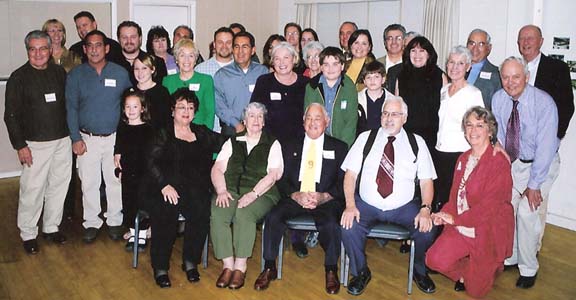
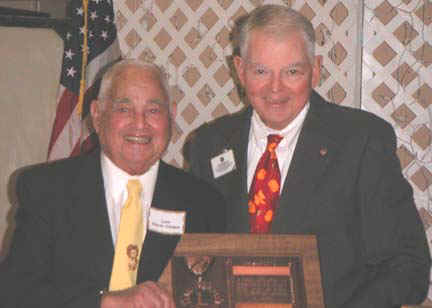
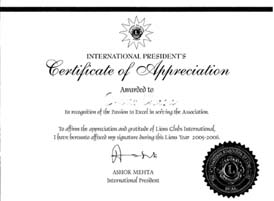
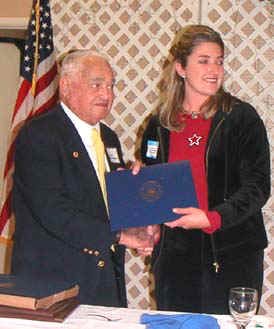
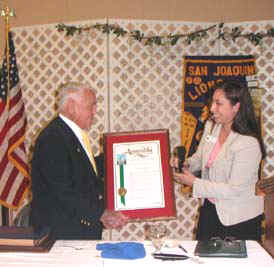
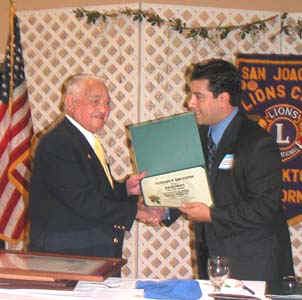
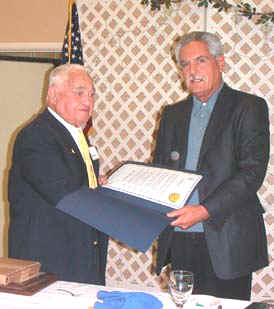
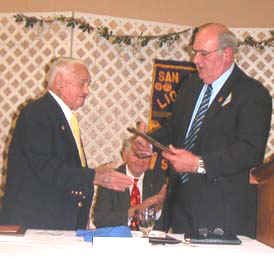
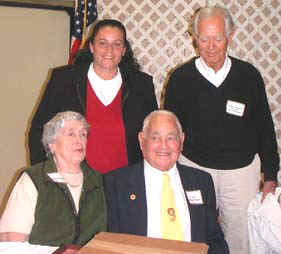
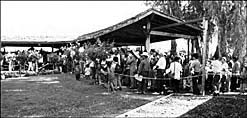
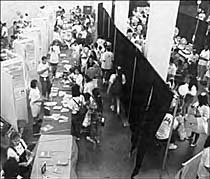
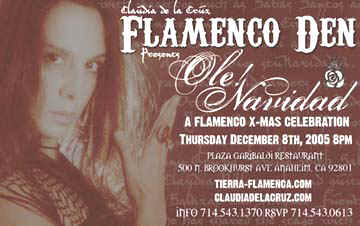


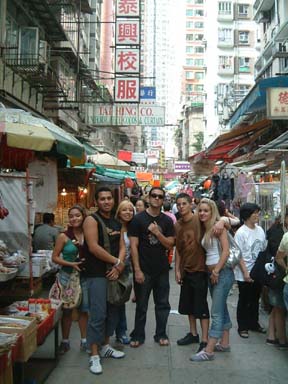
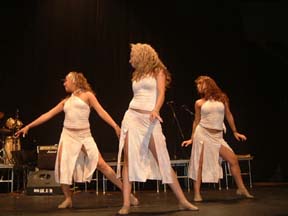
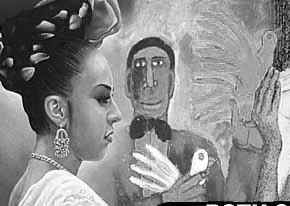
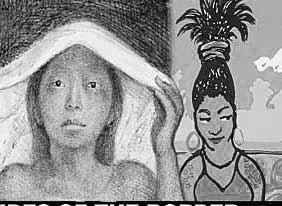
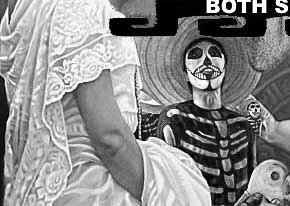
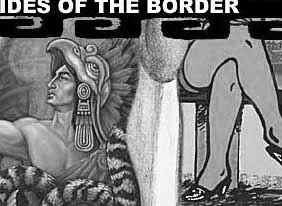
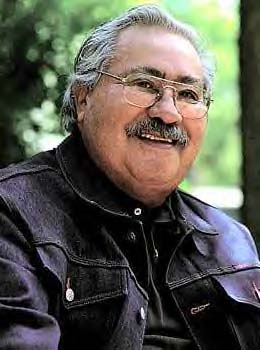
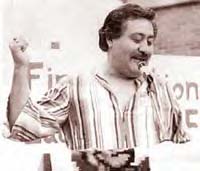
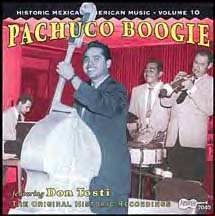
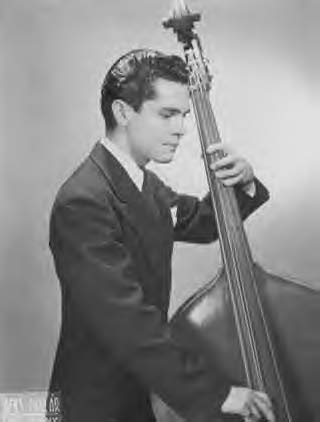
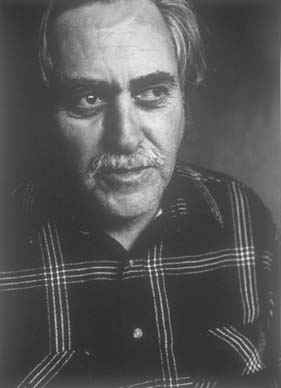
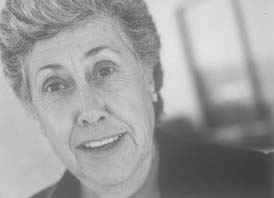

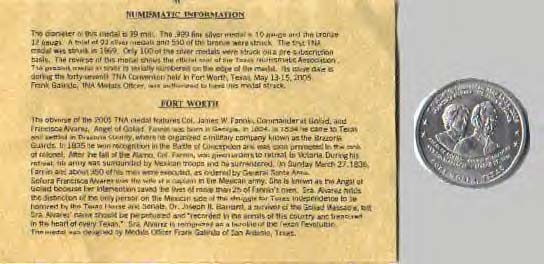

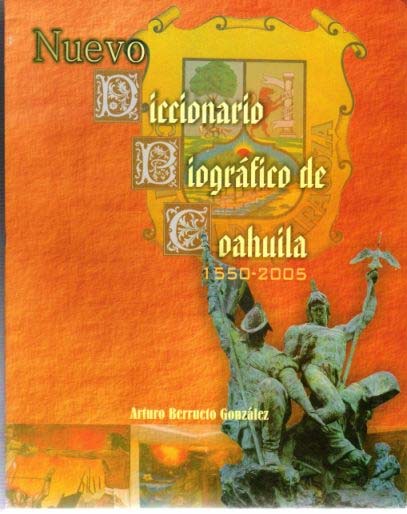
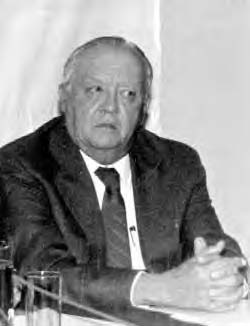
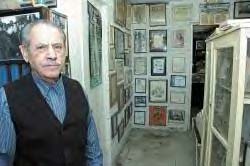
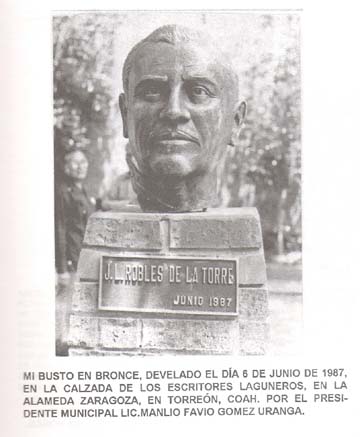
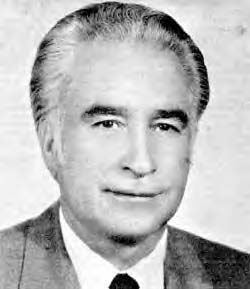

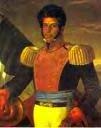

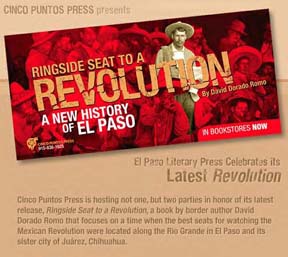
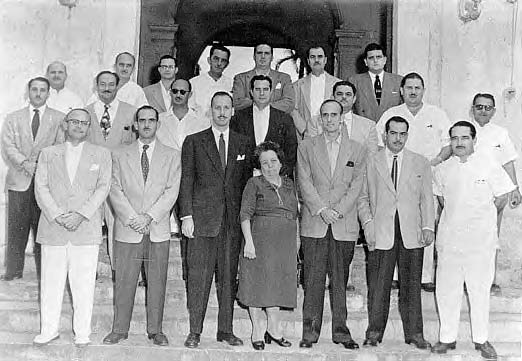
 José Antonio Rodríguez died on Sunday night 6 November 2005, in Copenhagen aged just 52 years old. Singer with Sierra Maestra since the beginning twenty-six years ago, he was considered as one of the best soneros (or singers of the son style) in Cuba. José Antonio (or ‘Maceo’ as he was known to his friends and admirers) was born in the Holguin province of Cuba and from early childhood dedicated himself to music. He was the co-founder and the soul of Sierra Maestra. He was baptised by the Cuban people as 'El Pequeno Gran Sonero', ‘The Little Big Sonero’ – a reference to his small stature. He was an excellent musician, singer, guitarist and above all an excellent person and a modest man whose talent never diverted him from being extremely straightforward.
José Antonio Rodríguez died on Sunday night 6 November 2005, in Copenhagen aged just 52 years old. Singer with Sierra Maestra since the beginning twenty-six years ago, he was considered as one of the best soneros (or singers of the son style) in Cuba. José Antonio (or ‘Maceo’ as he was known to his friends and admirers) was born in the Holguin province of Cuba and from early childhood dedicated himself to music. He was the co-founder and the soul of Sierra Maestra. He was baptised by the Cuban people as 'El Pequeno Gran Sonero', ‘The Little Big Sonero’ – a reference to his small stature. He was an excellent musician, singer, guitarist and above all an excellent person and a modest man whose talent never diverted him from being extremely straightforward.